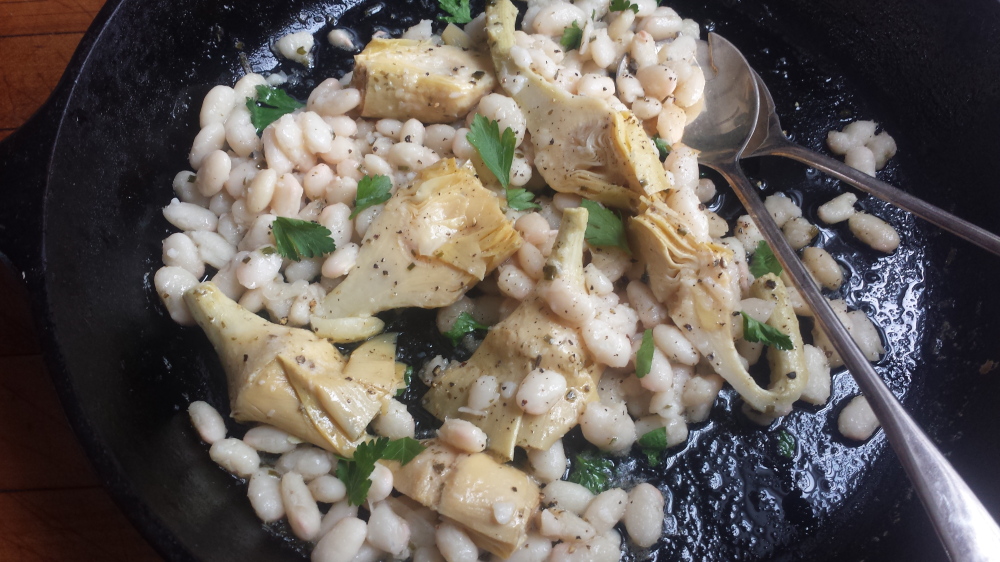Beans, beans, the musical fruit.
You probably know how the rest of that little schoolyard ditty goes. But did you know dried beans, an inexpensive source of plant protein with a list of nutrients as long as your fork, are also gentle on the environment? They enrich their own soil as bacteria in their root system converts atmospheric nitrogen to the kind of nitrogen that fertilizes growth for themselves, the plants growing around them and the ones that will sit in that soil after them.
None of this information provides solace to a cook who, like me, is rubbish at making a pot of beans. My failures range from undercooked nuggets to mush. Fearing yet another failure, I routinely reach for canned beans when I make my chili, pasta e fagioli or seven-layer dip.
Mitigating factors – like BPA-lined cans, the cost differential between canned and dried and my tenacious spirit (which likes to pounce on my fears) – have recently steeled my determination to rock a pot of beans. Well, that plus my culinary curiosity regarding whether my own beans would taste better than canned ones in my favorite dish from Nigel Slater’s “Eat,” my new go-to weeknight cookbook, simply titled “Artichokes and Cannellini” (see recipe).
Internet-supplied information on perfecting a pot of beans is voluminous, touching on everything from sourcing, soaking and salting to simmering and de-gassing. But I could not find definitive information on which cooking method requires the least amount of energy, both my own and that as recorded on my monthly utility bills.
After consulting with a couple of highly trained friends (an experimental physicist who works to understand the carbon cycle in the context of climate change and a computer scientist who tests computer networking products), I conducted my very own (very rudimentary) assessment in my kitchen. With the caveat that your mileage will vary wildly based on your equipment, method and beans, I give you my findings.
I bought four pounds of Great Northern Beans (the American name for cannellini) from Fairwinds Farm that were harvested and dried last fall. I brined each pound of beans for eight hours in four quarts of water laced with three tablespoons of table salt and cooked each with six cups of cold tap water until tender but not cracked. My test vessels were a stainless steel pot over a medium gas flame, a stovetop pressure cooker held steady on that same medium flame, my crockpot (circa 1994) and a borrowed but new electric pressure cooker. After many hours – most of it spent on the algebraic conversion that would let me directly compare the BTUs coming out of my Wolf burners to the reading on the P3 International Kill-A-Watt measurement tool my physicist friend lent me – I can report with a mere modicum of certainty that the most energy-efficient tool for cooking beans in my kitchen that day was the electric pressure cooker. It drew .28 kWh (kilowatt hours), compared with 1.87 kWh for the crock pot; 1.98 kWh for the stovetop pressure cooker; and 3.61 kWh for the plain old pot.
This information may not add up to a hill of beans for you because you may already have mastered the art of bean cookery. But I got 24 cups of cooked beans (they freeze really well, thank goodness), some hands-on insight into the power of pressure cooking as a time- and energy-saving apparatus and the satisfaction of putting a culinary fear to rest.
ARTICHOKES AND CANNELLINI
This recipe is adapted from one in Nigel Slater’s “Eat,” a very casual cookbook that features hundreds of recipes designed for those times when you just want to eat simple, great food quickly. If you’ve already cooked your beans (or tipped them from a can, no judging here), it hits the table in 10 minutes flat.
Serves 2
2 scallions
1 (10-ounce) jar marinated artichoke hearts
3 tablespoons unsalted butter
Half a lemon
2 cups cooked cannellini beans
Salt and pepper
Chopped parsley
Olive oil
Chop the scallions. Drain the artichoke hearts and slice each in half.
Melt the butter in a shallow pan over medium heat. As it melts, squeeze into the pan juice from the lemon. Add the artichoke hearts, then the beans. Let the mixture bubble to an impromptu sauce. Season with salt, pepper and parsley. Drizzle olive oil over the beans, and serve warm.
Christine Burns Rudalevige is a food writer, recipe developer and tester, and cooking teacher in Brunswick. Contact her at cburns1227@gmail.com.
Send questions/comments to the editors.


